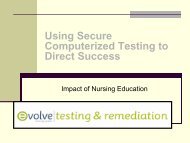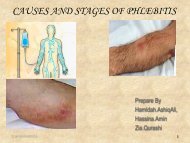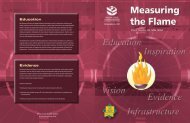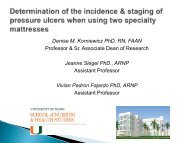Revision of the Barriers to Self-Care Scale Physical Activity ... - IUPUI
Revision of the Barriers to Self-Care Scale Physical Activity ... - IUPUI
Revision of the Barriers to Self-Care Scale Physical Activity ... - IUPUI
Create successful ePaper yourself
Turn your PDF publications into a flip-book with our unique Google optimized e-Paper software.
<strong>Revision</strong> <strong>of</strong> <strong>the</strong> <strong>Barriers</strong><br />
<strong>to</strong> <strong>Self</strong>-<strong>Care</strong> <strong>Scale</strong><br />
<strong>Physical</strong> <strong>Activity</strong><br />
Subscale<br />
Deborah Erickson Ph.D., R.N.<br />
July 15, 2010<br />
1
Facts About Diabetes<br />
• 23.6 million people in U.S.<br />
• Complications include heart disease, stroke,<br />
HTN, blindness, kidney disease, nervous<br />
system disease, & dental diseases<br />
• Economic impact in 2007:<br />
• $116 billion in direct health care costs<br />
• $58 billion from lost productivity<br />
2
Diabetes <strong>Self</strong>-management<br />
• Dietary management<br />
• Exercise/physical activity<br />
• <strong>Self</strong> blood glucose moni<strong>to</strong>ring<br />
• Medications<br />
3
Benefits <strong>of</strong> <strong>Physical</strong> <strong>Activity</strong><br />
• Improved glycemic control by<br />
• increasing action <strong>of</strong> insulin<br />
• Increasing uptake <strong>of</strong> insulin by muscle<br />
• Decreased risk for cardiovascular<br />
disease<br />
• Loss <strong>of</strong> body fat<br />
• Increased physical fitness<br />
• Enhanced psychological well-being<br />
4
Exercise & Diabetes<br />
• People with diabetes reported least likely <strong>to</strong><br />
follow recommendations for lifestyle changes<br />
such as diet and exercise (Ruggiero et al,<br />
1997)<br />
• Exercise significantly reduces HbA 1c (Boulé<br />
et al., 2001; Castaneda et al., 2002;<br />
Goldhaber-Fiebert et al., 2003; Di Lore<strong>to</strong> et al.,<br />
2003)<br />
5
Worksite Diabetes<br />
Management Program (WDMP)<br />
• Reduce absenteeism, increase employee<br />
retention, reduce health care costs, and<br />
increase employee satisfaction<br />
• Voluntary<br />
• Choose area <strong>of</strong> self-management<br />
• Theoretical framework: trans<strong>the</strong>oretical<br />
model <strong>of</strong> change (TTM)<br />
6
Theoretical Framework:<br />
Trans<strong>the</strong>oretical Model <strong>of</strong><br />
Change<br />
Stages <strong>of</strong> Change<br />
• Precontemplation: has no intention <strong>to</strong> change<br />
behavior in foreseeable future<br />
• Contemplation: is aware that a problem exists &<br />
considers making change in future<br />
• Preparation: intends <strong>to</strong> take action within next<br />
month & is making small changes<br />
• Action: changes behavior<br />
• Maintenance: continues with <strong>the</strong> changes made<br />
over a period <strong>of</strong> time<br />
7
The Study<br />
8
Hypo<strong>the</strong>sis<br />
<strong>Barriers</strong> <strong>to</strong> physical activity will be<br />
greater for individuals in <strong>the</strong> early<br />
stages <strong>of</strong> physical activity adoption as<br />
compared with individuals in <strong>the</strong> later<br />
stages <strong>of</strong> adoption.<br />
9
Design, Sample & Setting<br />
• Descriptive, cross-section, correlation research<br />
design<br />
• People with type 2 diabetes who were<br />
participants in a WDMP <strong>of</strong>fered by a<br />
manufacturing company in <strong>the</strong> Midwestern U.S.<br />
• Convenience sample <strong>of</strong> 600 people who met<br />
<strong>the</strong> inclusion criteria<br />
• Inclusion criteria: at least 18 years old, with type<br />
2 DM, enrolled in <strong>the</strong> WDMP for > 3 months,<br />
and able <strong>to</strong> participate in physical activity.<br />
10
Procedures<br />
• Letters introducing study sent <strong>to</strong> participants<br />
from WDMP <strong>of</strong>fice<br />
• Study materials sent <strong>to</strong> those indicating<br />
interest in participating<br />
• Returning response form and completed<br />
questionnaires implied consent<br />
• Approval from Rush University IRB and<br />
Bradley University CUHSR<br />
11
Instruments<br />
1. Demographic Questionnaire<br />
2. <strong>Physical</strong> <strong>Activity</strong> Staging Algorithm<br />
• 4 item instrument<br />
• Definition <strong>of</strong> physical activity: accumulation <strong>of</strong><br />
180 minutes <strong>of</strong> moderate intensity physical<br />
activity per week…it causes you <strong>to</strong> break in<strong>to</strong><br />
a sweat and/or increases your breathing rate<br />
3. <strong>Barriers</strong> <strong>to</strong> <strong>Self</strong>-<strong>Care</strong> <strong>Scale</strong> <strong>Physical</strong> <strong>Activity</strong><br />
Subscale (BSCS PAS)<br />
12
Instruments<br />
<strong>Barriers</strong> <strong>to</strong> <strong>Self</strong>-<strong>Care</strong> <strong>Scale</strong> <strong>Physical</strong> <strong>Activity</strong><br />
Subscale (BSCS PAS)<br />
• Original subscale contained 8 items<br />
• Literature review results<br />
13
<strong>Scale</strong><br />
<strong>Revision</strong><br />
Process<br />
14
<strong>Barriers</strong> Identified in<br />
Literature Review<br />
• Inconvenient (#1)<br />
• Not important (#3)<br />
• Equipment needs (#4 & #8)<br />
• Too busy/not enough time (#6)<br />
• O<strong>the</strong>r health problems (#7)<br />
• Lazy/not ready <strong>to</strong> change (pre-contemplative<br />
stage <strong>of</strong> change)<br />
15
<strong>Barriers</strong> Identified in<br />
Literature Review, cont.<br />
• No one <strong>to</strong> exercise with (#9)<br />
• No family support (#10)<br />
• Too overweight (#11)<br />
• Changes in DM management (#12)<br />
• No good place / no safe place (#13)<br />
• Boring/don’t like <strong>to</strong> exercise (#14)<br />
• It hurts/discomfort (#15)<br />
• I can’t do it (#16)<br />
16
Content Validity<br />
• The degree <strong>to</strong> which <strong>the</strong> items in an<br />
instrument adequately represent/measure <strong>the</strong><br />
content for <strong>the</strong> concept being measured<br />
• Utilize scale <strong>to</strong> determine relevance <strong>of</strong> item<br />
(Waltz, Strickland, & Lenz, 1991)<br />
• (1) not relevant<br />
• (2) somewhat relevant<br />
• (3) quite relevant<br />
• (4) very relevant<br />
17
Content Validity Index (CVI)<br />
• CVI equals <strong>the</strong> proportion <strong>of</strong> items given a<br />
rating <strong>of</strong> 3 or 4 by <strong>the</strong> judges<br />
• If all items are rated a 3 or 4 by both raters,<br />
<strong>the</strong> CVI = 1.0<br />
• If half <strong>of</strong> <strong>the</strong> items are jointly rated as 1 or 2,<br />
and <strong>the</strong> o<strong>the</strong>r half are jointly classified as 3 or<br />
4, <strong>the</strong> CVI = 0.50. This is an unacceptable<br />
level <strong>of</strong> content validity<br />
• CVI <strong>of</strong> .80 or greater is considered a good<br />
content validity (Polit & Beck, 2004)<br />
18
CVI <strong>of</strong> Proposed <strong>Barriers</strong> <strong>to</strong><br />
<strong>Physical</strong> <strong>Activity</strong> Subscale<br />
Judge 1<br />
Judge 2<br />
1 or 2 not/<br />
somewhat<br />
relevant<br />
3 or 4 quite/<br />
very relevant<br />
Total<br />
1 or 2 not/<br />
somewhat<br />
relevant<br />
3 or 4 quite/<br />
very relevant<br />
Total<br />
1 0 1<br />
7 8 15<br />
8<br />
8 16<br />
CVI (15/16)<br />
= 0.93<br />
19
Findings<br />
20
Sample Characteristics<br />
• 75/600 (12.5%) participants returned study<br />
materials that were used for analysis<br />
• Male (77.3%)<br />
• Caucasian (90.7%)<br />
• Age 45-69<br />
• Mean BMI 34.31<br />
• Some college education/degree (84%)<br />
• Employed/retired from management (50.6%)<br />
• Length <strong>of</strong> program participation<br />
21
Stage <strong>of</strong> Change<br />
for <strong>Physical</strong> <strong>Activity</strong><br />
Stage <strong>of</strong> Change for <strong>Physical</strong> <strong>Activity</strong><br />
• Precontemplation 7 9.3%<br />
• Contemplation 3 4.0%<br />
• Preparation 22 29.3%<br />
• Action 9 12.0%<br />
• Maintenance: 34 45.3%<br />
43 (56.3%) participants physically active<br />
22
Findings<br />
Reliability<br />
• Reliability is <strong>the</strong> consistency with which an<br />
instrument measures <strong>the</strong> attribute it is<br />
designed <strong>to</strong> measure (Polit & Beck, 2004)<br />
• Value range between .00 and +1.00, with<br />
higher values reflecting a higher internal<br />
consistency (Polit & Beck, 2004)<br />
• Cronbach’s alpha <strong>of</strong> <strong>the</strong> 16-item instrument<br />
was .704<br />
23
Hypo<strong>the</strong>sis<br />
Findings<br />
Participants who were physically active had<br />
significantly lower mean barrier scores than<br />
inactive participants (p
Findings<br />
<strong>Barriers</strong> with highest means<br />
• Item 12: “I think about how participating<br />
in physical activity could change how I<br />
manage my diabetes.” (M=2.99)<br />
• Item 5: “I feel sore & stiff.” (M=2.76)<br />
• Item 6: “I think about how much time it<br />
takes <strong>to</strong> participate in physical activity.”<br />
(M=2.76)<br />
25
Findings<br />
<strong>Barriers</strong> with lowest means<br />
• Item 10: “I am discouraged from<br />
participating in physical activity by o<strong>the</strong>rs.”<br />
(M=1.17)<br />
• Item 13: “I do not have a safe place <strong>to</strong><br />
participate in physical activity.” (M=1.24)<br />
• Item 8: “I think about <strong>the</strong> cost <strong>of</strong><br />
necessary equipment or fees for<br />
participating in physical activity.” (M=1.46)<br />
26
Limitations<br />
• Two judges determined content validity<br />
• Convenience sample<br />
• Participants were primarily male, Caucasian,<br />
management employees/retirees, & college<br />
educated<br />
• <strong>Self</strong>-report data<br />
• Selection bias<br />
• Cross-sectional design<br />
27
Conclusions<br />
• Revised BSCS PAS is a brief, internally<br />
consistent, self-report measure <strong>of</strong> barriers<br />
that interfere with DM self-management.<br />
– CVI <strong>of</strong> additional 8 items on <strong>the</strong> BSCS PAS was<br />
0.93<br />
– Internal consistency for <strong>the</strong> revised BSCS PAS<br />
was .704<br />
• Participants who were active had significantly<br />
lower mean barrier scores than inactive<br />
participants<br />
28
Future Research<br />
• Utilize revised scale in future studies<br />
• Possible translation in<strong>to</strong> Spanish<br />
29

















